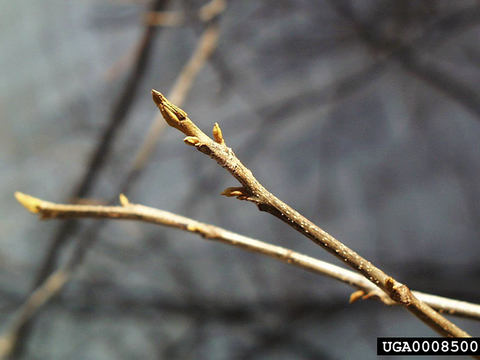The climate-ready woodlands tree lists provide planting recommendations for 11 ecoregions of Minnesota. Included on each of these lists are species that are not currently common in those regions but are predicted to thrive in Minnesota’s future climate and expand their range. Those species show what we call migration potential.
For example, bitternut hickory (Carya cordiformis) is recommended as a species with migration potential for the Northern Superior Uplands, which includes all of the northeast Arrowhead. Bitternut hickory is currently found in central and southern Minnesota, as well as throughout the eastern U.S., but is not considered native to the Arrowhead Region.
Moving species in response to climate change is called assisted migration. It is only one of many climate adaptation approaches that natural resource managers can use to manage forests for long-term health and productivity under a changing climate.
Reframing the definition of native ranges
The idea of moving species beyond their current range may cause hesitation and anxiety, especially when we think about the future changes in Minnesota’s forests due to climate change. In the era of climate change when the ranges of species and entire forest types are shifting, our understanding of native species is also changing.
Typically, native species have been defined by their geographic range: if a species is naturally found in southeast Minnesota, then it is considered native to southeast Minnesota. But the current ranges of tree species are not the same today as they once were; the glaciers last receded from Minnesota 12,000-10,500 years ago and our ecosystems have been changing ever since.
We are experiencing faster changes today as the climate warms rapidly, but Minnesota’s forest ecosystems have never been set. Each snapshot in time of species conglomerations will result in a slightly different list of species “native” or currently present in the state or ecoregion.
Furthermore, humans have been moving species within the United States and Minnesota since those glaciers receded. Never has Minnesota’s forest been untouched by humans.
Many indigenous communities value plants (and all beings), and the new Aanji-bimaadiziimagak o’ow aki: Climate Change Vulnerability Assessment report highlights indigenous relationships the Ojibwe community has had with all beings for centuries.
Native by association
Another way to think about native species involves looking at whether a species naturally fits into an environment and ecosystem. For example, bitternut hickory is adapted to temperate deciduous forests of the eastern U.S., tolerates mesic (moist) soils and dry upland soils, and is frequently found in diverse forests with a mix of different hardwood species. Matching bitternut hickory to those environmental and ecological conditions is more important than adhering to the strict boundaries of its historic geographic range, especially as regional climates change over time.
The species with migration potential that we are recommending already exist in the Eastern Deciduous Forest — the same broader ecosystem as our Minnesota forests — and share many of the same ecological associations, such as plant-pollinator relationships and natural competitors.
Invasive species, such as buckthorn, have been introduced from completely different ecosystems and continents where they share no natural competitors or ecological associations. So they lack any natural controls on their populations and can outcompete native species. A species is legally defined (or redefined) as "invasive" if it is proven to cause harm to the environment, economy or human health.
When we take an ecosystem-level view, especially in the context of climate change, the idea of native species becomes more nuanced. As our climate and ecosystems continue to change, so will our definition of native species.
Ecosystems are complex and dynamic on multiple levels, so we must think about the impacts of climate change not only on the scale of our own backyard woodlands but on the broad ecosystem scale.
Diversifying your woodland ecosystem
The main goal of the climate-ready woodlands project is to give you the knowledge and tools that you need to improve the diversity and resilience of your woodlands. We encourage you to try small-scale plantings of these migration potential species, keep an eye on them, and see how they perform.
All planting decisions, especially if you are interested in assisted migration, should be made in collaboration with a natural resource professional. They will help you find species that will perform well in the unique site conditions of your woodland.


